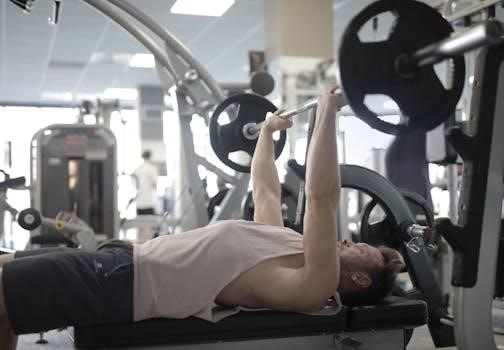Baseball Weight Training Program PDF⁚ An Overview
A baseball weight training program PDF offers structured guidance for athletes aiming to enhance strength, power, and overall performance. These programs often include exercises targeting various muscle groups, conditioning routines, and flexibility exercises to optimize baseball-specific movements and reduce injury risks.
Baseball strength training is a critical component for athletes seeking to improve their performance on the field. Unlike general fitness programs, baseball-specific strength training focuses on developing power, explosiveness, and endurance tailored to the demands of the sport. It emphasizes exercises that engage multiple muscle groups simultaneously, mimicking the dynamic movements involved in hitting, pitching, and fielding.
The goal is to enhance bat speed, throwing velocity, and overall agility while minimizing the risk of injuries. A well-designed baseball strength training program should incorporate compound exercises, such as squats, deadlifts, and bench presses, alongside targeted movements that strengthen the core, shoulders, and legs. These exercises promote the recruitment of many muscle groups, improving athletic performance.
Furthermore, a baseball strength training program addresses the unique physical requirements of different positions, recognizing that pitchers, hitters, and fielders require distinct training approaches. By focusing on these specific needs, athletes can maximize their potential and achieve peak performance throughout the season. Incorporating dynamic and static stretches, as well as hand-eye coordination drills, helps improve flexibility, joint warm-up, and prevent common injuries.

Off-Season Baseball Workout Plan (12 Weeks)
A 12-week off-season baseball workout plan is designed to build strength, speed, and agility. It incorporates full-body strength training, speed and agility drills, core work, and recovery periods. The plan aims to prepare players for the upcoming season.
Full-Body Strength Training (Day 1)
Day 1 focuses on full-body strength training, essential for baseball players to enhance overall power and resilience. This session incorporates compound exercises that engage multiple muscle groups simultaneously, maximizing efficiency and promoting functional strength. A typical workout might include squats to build lower body power, crucial for hitting and fielding. Bench presses develop upper body strength, vital for throwing and hitting with force. Deadlifts are incorporated to enhance overall strength and power, engaging the posterior chain.
Overhead presses contribute to shoulder strength and stability, essential for throwing accuracy and power. Rows build back strength, helping to balance the chest muscles and improve posture. These exercises are performed with controlled movements and proper form to prevent injuries; Sets and repetitions are structured to promote strength gains and muscle development. A thorough warm-up and cool-down are included to prepare the body for the workout and aid in recovery. This comprehensive approach ensures athletes build a solid foundation of strength.
This foundational strength will translate to improved performance on the field during the baseball season. Emphasis should be on proper technique and gradual increases in weight, to ensure continuous improvement throughout the workout.
Speed and Agility Training (Day 2)
Day 2 concentrates on speed and agility training, vital for baseball players needing quick reactions and movements. This session emphasizes drills that enhance footwork, acceleration, and change of direction. Agility ladder drills improve foot speed and coordination, crucial for fielding ground balls and base running. Cone drills focus on agility and quick changes in direction, mimicking game situations. Sprinting exercises, including short bursts and resisted sprints, build explosive speed.
Plyometric exercises, such as box jumps and jump squats, develop explosive power and agility. These exercises improve the athlete’s ability to generate force quickly, essential for sprinting and jumping. Shuttle runs enhance agility and conditioning, requiring athletes to quickly change direction while maintaining speed. Dynamic stretching is incorporated to improve flexibility and prepare the muscles for intense activity. Reaction drills, where athletes respond to visual or auditory cues, improve reaction time and decision-making.
Proper warm-up and cool-down routines are essential to prevent injuries and promote recovery. This comprehensive approach ensures athletes develop the speed, agility, and quickness necessary to excel on the baseball field. The focus will be on proper running form to maximize the benefits from each drill and prevent injury. This day will contribute to a well-rounded baseball player that is able to perform at a high level.
Core and Stability Work (Day 4)
Day 4 focuses on core and stability work, essential for baseball players to generate power and maintain balance. A strong core enhances rotational power for hitting and throwing, while stability prevents injuries. Exercises include planks, side planks, and Russian twists to strengthen the abdominal muscles. Medicine ball throws and wood chops improve rotational power and core strength. Stability ball exercises, like crunches and back extensions, challenge balance and engage core muscles.
Exercises such as bird dogs and dead bugs improve core stability and coordination. These movements enhance the athlete’s ability to control their body during dynamic actions. Anti-rotation exercises, such as Pallof presses, build core strength and prevent unwanted movement during swings and throws. Farmer’s walks and suitcase carries improve grip strength and core stability. These exercises require the athlete to maintain a stable posture while carrying weight.
Proper form and controlled movements are emphasized to maximize effectiveness and prevent injuries. Progressive overload is applied to gradually increase the difficulty of exercises. This day is crucial for developing a resilient and powerful core, enabling baseball players to perform at their best and reduce the risk of injuries. Integrating core and stability work into the training program ensures a well-rounded and balanced athletic development.

In-Season Strength Program
An in-season strength program maintains strength and power developed during the off-season. It focuses on fewer high-intensity workouts, preventing overtraining and fatigue. Exercises prioritize compound movements and core stability, ensuring players remain strong and resilient throughout the baseball season.
Maintaining Strength During the Season
Maintaining strength during the baseball season is crucial to prevent performance decline and reduce injury risk. In-season training should prioritize maintenance over gains, focusing on preserving the strength and power developed during the off-season. The goal is to minimize fatigue while still providing enough stimulus to prevent muscle atrophy.

Frequency and intensity are key considerations. Reduce the number of weekly strength training sessions to allow for adequate recovery between games and practices. Focus on compound exercises that engage multiple muscle groups, such as squats, deadlifts, and bench presses, but decrease the volume and weight compared to the off-season program.
Incorporate exercises that improve core stability and rotational power, essential for baseball-specific movements like hitting and throwing. Include exercises like medicine ball throws, cable rotations, and planks. Proper nutrition and hydration are also vital for recovery and maintaining muscle mass throughout the season.
Prioritize sleep and manage stress levels to optimize recovery. Listen to your body and adjust the training program as needed to avoid overtraining. Regular monitoring of performance metrics can help identify potential fatigue and allow for timely adjustments to the training plan.

Sample Baseball Strength Training Exercises
Baseball strength training includes compound movements like squats, deadlifts, and bench presses. It also features baseball-specific exercises such as medicine ball throws and rotational exercises. These exercises build power, strength, and stability for enhanced on-field performance and injury prevention.
Compound Exercises for Baseball Players
Compound exercises are multi-joint movements that engage numerous muscle groups simultaneously, making them highly effective for baseball players seeking to enhance overall strength and power. These exercises are fundamental to any baseball weight training program PDF, as they mimic the coordinated muscle activation patterns seen in baseball actions like hitting, throwing, and running.
Squats, for instance, are a cornerstone of lower body strength development. They target the quadriceps, hamstrings, and glutes, contributing to explosive power during sprints and jumps. Deadlifts are another essential compound exercise, building overall strength and particularly strengthening the posterior chain, crucial for generating power in hitting and throwing.
Bench presses are vital for upper body strength, targeting the chest, shoulders, and triceps. Strong upper body muscles contribute to powerful throws and improve bat speed. Overhead presses further enhance shoulder strength and stability, essential for preventing injuries associated with throwing motions.
Incorporating these compound exercises into a baseball weight training program PDF provides a solid foundation for building functional strength and power, ultimately translating to improved performance on the baseball field.